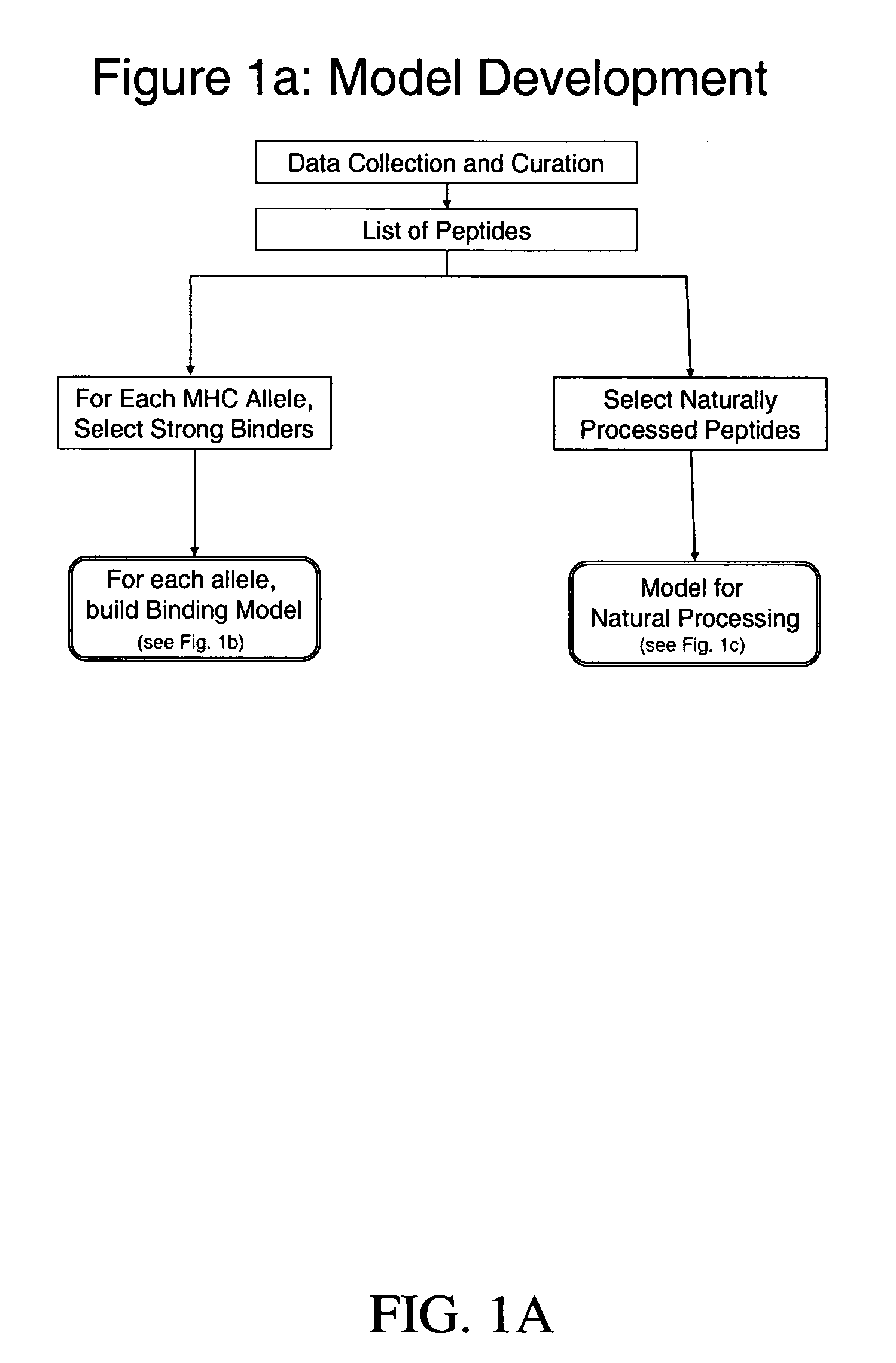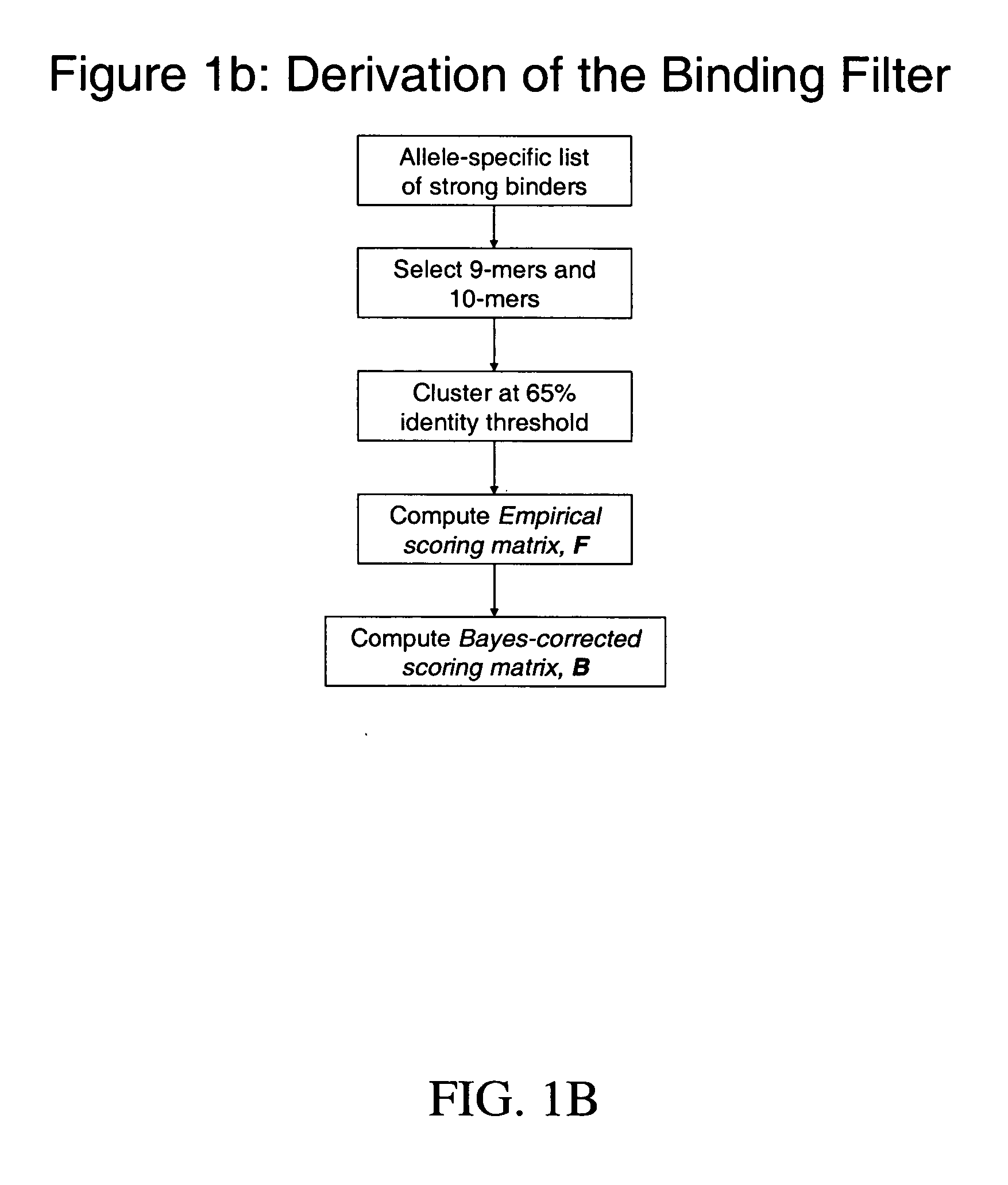System and method for automated selection of T-cell epitopes
- Summary
- Abstract
- Description
- Claims
- Application Information
AI Technical Summary
Benefits of technology
Problems solved by technology
Method used
Image
Examples
example 1
Derivation of a Bayes-Corrected Scoring Matrix from Binding Data for the Murine Class I Molecule H-2Kd
[0169] This example illustrates how the methodology of the disclosed invention is used to derive a Bayes-corrected scoring matrix for the murine MHC Class I allele H-2Kd.
Step 1: Identify Strong Binders to H-2Kd
[0170] As of Jan. 30, 2005, 51 (fifty one) unique strong binders to H-2Kd were available from the aforementioned epitope databases (Jenpep, MHCBN, and FIMM). The peptides were obtained by selecting the option “Report strong binders to H-2Kd”, in each of the three databases. The identified peptides are listed in Table 1 (SEQ ID NOS.: 90-99 (8 mers), SEQ ID NOS.: 1-38 (9 and 10 mers), and SEQ ID NO.: 100 (11 mer), SEQ ID NO.: 101 (12 mer), AND SEQ ID NO.: 102 (13 mer), respectively). Thirty eight (38) of the strong binders were 9-mers and l0-mers (SEQ ID NOS.: 1-38) and were retained for further analysis. The other 13 peptides reported in the databases were of lengths shorte...
example 2
Use of a Bayes-Corrected Scoring Matrix to Score Candidate Peptides
Step 1: Define Candidate Peptides of Target Protein
[0175] All possible 9mer and 10-mer frames (longer and shorter frames are not considered because most binders to Class I HLA molecules are of length 9 to 10) are determined in silico from the amino acid sequence of a target protein of interest.
Step 2: Score and Rank Candidate Peptides
[0176] Score each fragment using BSM as follows:
[0177] For each 9-mer a1 . . . a9, its score is obtained by simply adding the appropriate entries of the BSM: S(a1⋯ a9)=∑i=1 … 9B(ai,i)
For each 10-mer a1 . . . a10, its score is obtained by adding the scores of the 8 flanking amino acids and the average of the scores of the middle two positions: S(a1⋯ a10)=∑i=1 … 4B(ai,i)+∑i=7 … 10B(ai,i-1)+B(a5,5)+B(a6,5)2
The output of binding affinity filter is a list of 9-mer and 10-mer peptide fragments ranked by their scores.
example 3
T-Cell Epitope Discovery in HCV-1
[0178] To validate the binding affinity filter described in this invention, we obtained 12 (twelve) published A2-restricted epitopes from the HCV virus from [P. Scognamiglio et al., J Immunol 1999, 162: 6681-6689]. The binding affinity of each epitope to the HLA-A2 was measured in a standard competitive inhibition assay against a radiolabeled probe peptide (see detailed protocol in the above-referenced paper). The epitopes (SEQ ID NOS.: 39-50, respectively) and their IC50 values are shown in Table 5.
TABLE 5HLA-A2-restricted HCV epitopes fromP. Scognamiglio et.al., J Immunol. 1999, 162:6681-6689.Binding AffinityPeptide(IC50, nM)DLMGYIPLV80.0YLVAYQATV20.4ILAGYGAGV116.3YLLPRRGPRL125.0VLVGGVLAA185.2FLLLADARV18.2LLFNILGGWV4.2RLIVFPDLGV56.2HMWNFISGI15.2YLVTRHADV454.5LLFLLLADA217.4WMNRLIAFA122.0
[0179] Separately, we derived a Bayes-corrected scoring matrix for HLA-A2 from a set of 289 unique, naturally occurring strong binders, following the data extract...
PUM
| Property | Measurement | Unit |
|---|---|---|
| Fraction | aaaaa | aaaaa |
| Immunogenicity | aaaaa | aaaaa |
| Affinity | aaaaa | aaaaa |
Abstract
Description
Claims
Application Information
 Login to View More
Login to View More - R&D
- Intellectual Property
- Life Sciences
- Materials
- Tech Scout
- Unparalleled Data Quality
- Higher Quality Content
- 60% Fewer Hallucinations
Browse by: Latest US Patents, China's latest patents, Technical Efficacy Thesaurus, Application Domain, Technology Topic, Popular Technical Reports.
© 2025 PatSnap. All rights reserved.Legal|Privacy policy|Modern Slavery Act Transparency Statement|Sitemap|About US| Contact US: help@patsnap.com



